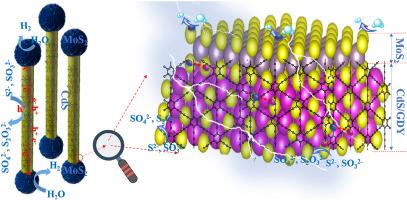Materials Today Physics ( IF 11.5 ) Pub Date : 2022-06-24 , DOI: 10.1016/j.mtphys.2022.100767 Lijun Zhang , Youlin Wu , Junke Li , Zhiliang Jin , Youji Li , Noritatsu Tsubaki

|
The basic energy conversion in the photosynthetic system is the process of separation, transfer and utilization of photogenerated charges. Here, an amorphous/crystalline heterojunction photocatalyst with spatial separation effect is prepared by assembling graphdiyne (GDY) flakes onto MoS2–CdS nanodumbbells. Graphdiyne flexible flakes were synthesized via a Glazer-Hay coupling reaction using cuprous bromide (CuBr) as a catalyst. One-dimensional MoS2–CdS nanodumbbells with symmetrical amorphous MoS2 tips can effectively promote the separation of electrons and holes in space, attracting photogenerated electrons to move along the one-dimensional nanorods. The GDY two-dimensional flexible sheet, which can promote the outward movement of photogenerated holes and isolate the surface oxidation sites, is like a “protective suit” on the dumbbell structure, thereby improving the resistance to photocorrosion. The MoS2–CdS/GDY-10% composite photocatalyst shows the highest photocatalytic water splitting activity of graphdiyne applied to photocatalytic systems so far, and the highest hydrogen production rate can reach 17.99 mmol g−1h−1, which is 161 times that of pure CdS. The conversion efficiency of solar energy to hydrogen energy can reach 3.2%. The highest quantum efficiency is 6.48% at 450 nm. The synergistic effect of the special spatial structure and the amorphous/crystalline heterojunction can significantly reduce the recombination of electron-hole pairs and prolong the lifetime of photogenerated carriers. This work inspires the construction of graphdiyne-based photocatalysts with high activity and high stability, demonstrating the promising future of graphdiyne for photocatalytic water splitting.
中文翻译:

非晶/晶体异质结界面驱动电荷载体的空间分离以实现高效的光催化析氢
光合系统的基本能量转换是光生电荷的分离、转移和利用的过程。在这里,通过将石墨二炔(GDY)薄片组装到MoS 2 -CdS纳米哑铃上,制备了具有空间分离效应的非晶/结晶异质结光催化剂。使用溴化亚铜 (CuBr) 作为催化剂,通过 Glazer-Hay 偶联反应合成石墨二炔柔性薄片。具有对称非晶 MoS 2的一维 MoS 2 –CdS 纳米哑铃尖端可以有效促进空间中电子和空穴的分离,吸引光生电子沿一维纳米棒移动。GDY二维柔性片材,可以促进光生空穴向外运动,隔离表面氧化位点,就像哑铃结构上的“防护服”,从而提高抗光腐蚀能力。MoS 2 -CdS/GDY-10%复合光催化剂表现出石墨二炔迄今为止应用于光催化系统的最高光催化水分解活性,最高产氢率可达17.99 mmol g -1 h -1,是纯 CdS 的 161 倍。太阳能向氢能的转化效率可达3.2%。在 450 nm 处的最高量子效率为 6.48%。特殊空间结构与非晶/晶异质结的协同作用可以显着减少电子-空穴对的复合,延长光生载流子的寿命。这项工作启发了具有高活性和高稳定性的石墨二炔基光催化剂的构建,展示了石墨二炔用于光催化水分解的广阔前景。



























 京公网安备 11010802027423号
京公网安备 11010802027423号